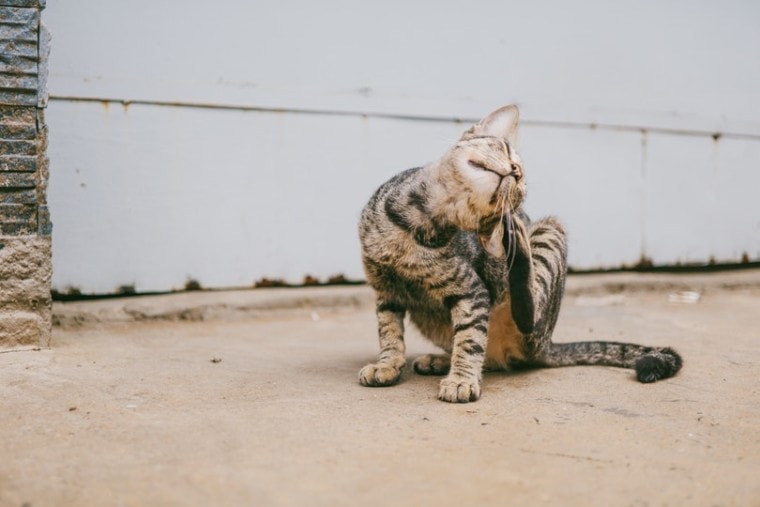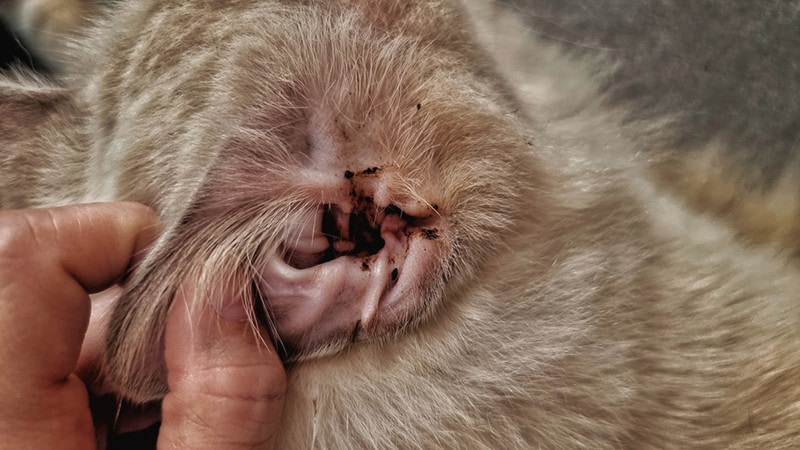
Click to Skip Ahead
If your cat is experiencing frequent ear infections that appear difficult to treat there may be an underlying issue such as an ear polyp. Ear polyps in cats are benign (non-cancerous) inflammatory growths usually seen in the external ear canals of younger cats. They present as pink fleshy masses. The clinical signs witnessed are associated with the location of the polyp in the ear and the area the polyp is growing into.
Ear polyps can cause a great deal of discomfort and can cause loss of hearing depending on their location. Ear polyps can be congenital (present from birth) or the result of a chronic infection. Prompt diagnosis and treatment from your vet are important for a good resolution and prognosis.
What are Ear Polyps in Cats?
A polyp is a benign pedunculated growth that usually originates from connective tissue. Cats commonly get inflammatory polyps in their ears. These polyps are composed mainly of inflammatory cells and fibrous tissue and are thought to originate in the middle ear and eustachian tubes. They develop from the mucosal lining of a part of the ear called the tympanic bulla, the auditory tube, or the pharyngeal mucosa. When growing, the polyp can take different pathways, causing very different clinical signs depending on its location. This can range from acute breathing difficulty to otitis externa. Inflammatory polyps are usually seen in younger cats (under 2 years of age)
The actual cause is unknown; however, it is thought that there could be a genetic predisposition or infectious factors.

What Are the Signs of Ear Polyps in Cats?
Clinical signs do largely depend on the location of the polyp and the direction it is progressing towards. Signs of a polyp are often very similar to signs of an ear infection in cats.
In some cases, owners can visibly see the polyp. They usually present as a pink, white, or red pedunculated mass. Some are ulcerated. They are normally oval-shaped. They have a shiny surface due to the fact they are covered with mucosa.

What Are the Causes of Ear Polyps in Cats?
The exact cause of ear polyps in cats is unknown. Some theories indicate they may develop as a response to chronic inflammation. Other research points towards chronic infection either from bacteria, fungi, or viruses. Another suggestion is that they develop from the remains of the branchial arches which are structures present early on when the fetus is developing.
When the kitten is born, the branchial arches usually shrink away and regress, but in this case, they remain, as a polyp. Ear polyps are typically seen in younger cats, often under a year old.
Diagnosis of Ear Polyps in Cats
Depending on the location of the polyp, they can be spotted and diagnosed with ease, or they can present quite a challenge. If they grow to be large enough, they can be seen in the ear canal with the naked eye. If they are smaller or deeper in the canal, an otoscope is often required to visualize what is going on. Many cats will require sedation or general anesthetic to fully examine the ear canal to the tympanic membrane. Your vet will also examine the back of the throat above the soft palate, the mouth, and the nasal cavity. This is because some ear polyps can grow through the eustachian tube (the auditory tube) and can be seen as a mass at the back of the throat.
The ear polyps are often found in the horizontal part of the ear canal. A biopsy of the polyp is required to send for histological analysis. This will allow your vet to determine if the mass seen is a benign polyp or something malignant. X-rays of the head may be useful in some cases to assess the extent of the growth. The limitations of X-rays are that they are not able to distinguish between a polyp or changes due to infection or inflammation. Other diagnostic tools that can be useful are endoscopes, CT (computed tomography), or MRI (magnetic resonance imaging).

How Do I Care for a Cat with Ear Polyps?
The normal treatment for polyps is surgical excision. The anatomy of a polyp is unique in that they are attached by a long thin stalk. Often if traction is applied to the polyp, the stalk can be cut at the very end and the polyp removed. This method does come with a high rate of recurrence. Depending on the experience of the surgeon, 14% to 35% of the polyps removed by this method regrow. Removal of the polyp in this way is done mainly to reduce the clinical signs in the short term as the likelihood of recurrence is high.
Often a more skilled surgical procedure is carried out called a Ventral Bulla Osteotomy. This involves the removal of the lower part of the bone that surrounds the inner ear to create an opening into the middle ear cavity. This allows for complete removal of the whole polyp including the root. This method has an extremely low recurrence rate however it is a major operation and complications are often seen. If your cat is not a suitable surgical candidate, anti-inflammatory drugs may be used to attempt to reduce the size of the polyp. This is a less effective option.

 Frequently Asked Questions (FAQs)
Frequently Asked Questions (FAQs)
Can a cat live with ear polyps?
Cats can live with ear polyps, however, they can grow to be very large and become painful or cause hearing or breathing uses. It is rare for an ear polyp to result in the death of a cat. Once they have been diagnosed, there is no way to predict how disruptive they will become so the best option is to remove the polyp. The prognosis for ear polyps is good. Vets are able to treat most cases with surgical excision.
Can ear polyps be cancerous in cats?
A polyp by definition is a benign mass. This means it is not cancerous or malignant and it will not metastasize (spread) to other places in the body. They will still grow steadily and occupy a lot of the space used for important functions such as hearing, breathing, and swallowing, so they can still be destructive.
Are cat ear polyps painful?
Ear polyps can grow into places where they interfere with the ear’s normal function. The pressure on the external structures can cause pain. If the polyp is causing a blockage in the ear, this can lead to a build-up of wax and the development of infection. This in turn can be painful for your cat.

Conclusion
Ear polyps in cats can be a challenging issue to diagnose and treat. They cause different clinical signs depending on their location. They are more often seen in younger cats. There are a few different options for removal, gentle traction can be applied, and they can be excised at the stalk. This offers short-term relief, but they are very likely to recur if the root is left. A surgical procedure called a ventral bulla osteotomy allows for access and removal of the whole of the polyp. This means there is only a minimal chance of recurrence.
If you suspect your cat has a polyp or similar medical issue, contact your vet to arrange an appointment.
Featured Image Credit: FOX, Pexels






